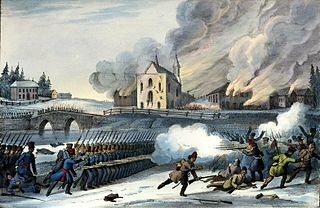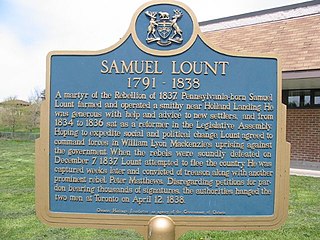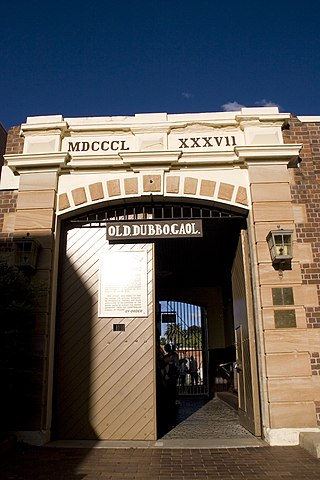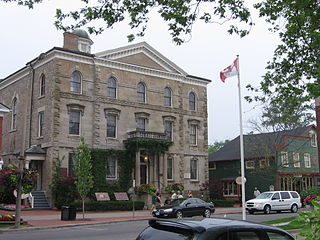
The Upper Canada Rebellion was an insurrection against the oligarchic government of the British colony of Upper Canada in December 1837. While public grievances had existed for years, it was the rebellion in Lower Canada, which started the previous month, that emboldened rebels in Upper Canada to revolt.

The Rebellions of 1837–1838, were two armed uprisings that took place in Lower and Upper Canada in 1837 and 1838. Both rebellions were motivated by frustrations with lack of political reform. A key shared goal was responsible government, which was eventually achieved in the incidents' aftermath. The rebellions led directly to Lord Durham's Report on the Affairs of British North America and to the Act of Union 1840 which partially reformed the British provinces into a unitary system and eventually led to the British North America Act, 1867, which created the contemporary Canadian federation and its government.

St. Lawrence is a neighbourhood located in downtown Toronto, Ontario, Canada. The area, a former industrial area, is bounded by Yonge, Front, and Parliament Streets, and the Canadian National railway embankment. The Esplanade off Yonge St., lined with restaurants, cafés and hotels runs through the middle of the area. In previous times, the area was sometimes referred to as 'St. Lawrence Ward' or more often today as 'St. Lawrence Market', synonymous with the large retail vendor market which is the neighbourhood's focal point. The area is the site of a large city-sponsored housing project of the 1970s, which revitalized an old brownfields area. The boundaries of the St Lawrence Neighbourhood Association and the St Lawrence Market BIA are somewhat larger than those noted above. Both groups have boundaries that extend from Yonge to Parliament Streets and Queen Street East to the rail corridor.

Events from the year 1838 in Canada.

The Republic of Canada was a government proclaimed by William Lyon Mackenzie on December 5, 1837. The self-proclaimed government was established on Navy Island in the Niagara River in the latter days of the Upper Canada Rebellion.

York County is a historic county in Upper Canada, Canada West, and the Canadian province of Ontario. It was organized by the Upper Canada administration from the lands of the Toronto Purchase and others.

The Battle of Montgomery's Tavern was an engagement which took place on December 7, 1837 during the Upper Canada Rebellion. The abortive revolutionary insurrection, inspired by William Lyon Mackenzie, was crushed by British authorities and Canadian volunteer units near John Montgomery's tavern on Yonge Street at Eglinton, north of Toronto.

The Don Jail was a jail in Toronto, Ontario, Canada, located to the east of the Don River, on Gerrard Street East in the Riverdale neighbourhood. The original building was completed in 1864 and was reopened in 2013 to serve as the administrative wing of Bridgepoint Active Healthcare, a rehabilitation hospital located adjacent to the jail. Prior to its adaptive reuse as part of a healthcare facility, the building was used as a provincial jail for remanded offenders and was officially known as the Toronto Jail. The jail originally had a capacity of 184 inmates, and it was separated into an east wing for the men and a west wing for the women.

Samuel Lount was a blacksmith, farmer, magistrate and member of the Legislative Assembly in the province of Upper Canada for Simcoe County from 1834 to 1836. He was an organizer of the failed Upper Canada Rebellion of 1837, for which he was hanged as a traitor. His execution made him a martyr to the Upper Canadian Reform movement.

Captain Peter Matthews was a farmer and soldier who participated in the Upper Canada Rebellion of 1837.
German Mills is a community within the city of Markham in Ontario, Canada. The easternmost community in the historic town of Thornhill, German Mills was named for the early German settlers in the area.
The Huron Historic Gaol was established as the Huron County Gaol for Upper Canada's Huron District. Clearing of the land began in Goderich, Ontario in 1839 and the jail was constructed between 1839 and 1842 using stone from the Maitland River Valley and from Michigan. The octagonal jail was designed by Thomas Young, modelled after Jeremy Bentham’s Panopticon design for prison construction, common in mid-19th century Britain and North America.

Toronto Necropolis is a non-denominational cemetery in Toronto, Ontario, Canada. It is located on the west side of the Don River valley, to the north of Riverdale Farm in the Cabbagetown neighbourhood.

The King Street Gaol was Toronto's first jail, built in 1798 on the outskirts of York, Upper Canada. A log structure with 10 cells and a hanging yard, it was located on the south-east corner of King Street and Yonge Street, where the King Edward Hotel stands today. The jail quickly fell into disrepair, leading it to be abandoned. The east cells of the jail were completely rotten, the ceilings in the different rooms were insufficient, and the sheriff didn't feel safe when having to confine prisoners in cells or debtor's rooms. It was replaced by a brick jail in 1824.

The Ottawa Jail Hostel is a hostel operated by Saintlo Hostels and located at 75 Nicholas Street in Ottawa, Ontario, Canada. The hostel was originally the Carleton County Gaol (jail), more commonly known as the Nicholas Street Gaol or Ottawa Jail. When the jail closed in 1972, Hostelling International purchased and converted the building, but left much of the structure intact, allowing guests to experience spending a night "in jail". The top floor, which had served as the jail's death row, has been restored to much of its original condition and daily tours were conducted until December 31, 2023. The Ottawa Jail Hostel, ran by Saintlo Hostels decided to end the partnership with The Haunted Walk in order to focus those spaces on accommodations instead.

The Old Dubbo Gaol is a heritage-listed former gaol and now museum and tourist attraction at 90 Macquarie Street, Dubbo in the Dubbo Region local government area of New South Wales, Australia. The gaol was designed by the NSW Colonial Architect's Office and was built from 1847 to 1945 by James Atkinson Jnr (1862–63) and William Bonython Moffatt. The gaol was added to the New South Wales State Heritage Register on 26 March 2004. It was the second gaol in Dubbo, replacing lock-ups built in 1847 and 1862.

Joseph Sheard was an English architect and politician. He was Mayor of Toronto from 1871 to 1872.

The Heintzman House, also known as Sunnyside Manor Farm, is one of the oldest buildings in Thornhill-Markham, Ontario, where it sits on the crest of Bay Thorn Drive.

The Union Building is an older building in Toronto that has been described as an "architectural gem". When it was built, in 1908, on the Northwest corner of King and Simcoe streets, it was directly across from the palatial official residence of the Lieutenant Governor of Ontario.

Niagara District Court House, better known as the Court House Theatre, is a former court house and venue for the Shaw Festival in Niagara-on-the-Lake, Ontario, Canada.

















